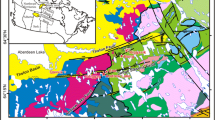Abstract
Niuxinshan is a typical example of the numerous mesothermal gold deposits formed during Mesozoic tectono-magmatic reactivation of the Archean North China Craton in eastern Hebei province. Gold occurs in quartz-sulfide lodes in Archean amphibolites and also in greisen zones in the Mesozoic Niuxinshan granite stock. Four mineralization stages can be recognized from early to late: (1) quartz-K-feldspar, (2) quartz-pyrite, (3) quartz-polysulfide, and (4) quartz-carbonate. Gold mineralization mainly occurs in stages 2 and 3. Fluid inclusions in quartz and fluorite from greisen zones in the Niuxinshan granite, and inclusions in vein quartz and sphalerite from stages 1 to 3 in the amphibolites, have been studied by microthermometry. Three compositional types of inclusions are recognized: type 1 (Tp1) are H2O-CO2-bearing inclusions and include primary (Tp1-P) and secondary (Tp1-S) inclusions. These are found in quartz and fluorite from the greisen zones as well as in vein quartz and sphalerite from stages 1 to 3. The Tp1-P inclusions are considered to represent the gold-bearing hydrothermal fluids. Type 2 (Tp2-S) are secondary H2O-CO2 + solid phase inclusions in fluorite from the greisen zones. Type 3 (Tp3-S) are secondary aqueous inclusions with a solid phase which coexist with the Tp2-S in fluorite from the greisen zones. The Tp1-P inclusions show variable VCO2 (commonly 0.3 to 0.6) and XCO2 values (mainly 0.1 to 0.4). The salinities of inclusions cluster around 3 to 11 wt.% NaCl equivalent and their homogenization temperatures to the liquid phase (Th(L)) fall dominantly in the range of 260 to 360 °C. The compositional variations of inclusions in stage 1 probably result from exsolution of magmatic fluids at various stages; immiscibility or boiling of the fluids can be ruled out. The compositional variations of inclusions in the greisen zones and in vein stages 2 and 3 are attributed to cooling, mixing (dilution), and necking-down of the fluids. The Tp1-S and Tp2-S inclusions show salinities of 3 to 6 wt.% NaCl equivalent and XCO2 values of 0.04 to 0.17. Th(L) clusters at 240 to 260 °C. The Tp3-S inclusions have salinities of 3 to 6 wt.% NaCl equivalent and Th(L) of 170 to 240 °C. Isochoric reconstructions, combined with oxygen and sulfur isotope geothermometry of mineral pairs, give trapping P-T conditions for the gold-bearing fluids. The greisen zones formed at 310 to 460 °C and 1.3 to 3.7 kbar; stage 1 veins at 300 to 430 °C and 1.2 to 3.7 kbar; stage 2 veins at 290 to 380 °C and 1 to 3 kbar; stage 3 veins at 250 to 350 °C and 1 to 3 kbar. H2O-CO2 fluids with low to moderate salinities and moderate to high densities (0.66 to 1.01 g/cm3) dominated at early mineralization stages, and evolved towards H2O-richer and CO2- and less saline fluids through time. The retrograde P-T evolution probably resulted from regional uplift and cooling of gold-bearing hydrothermal fluids. The gold bisulfide complex was dominant in the fluids during mineralization and gold deposition was mainly induced by decreases of temperature and pressure, as well as destabilization of the bisulfide complex during sulfidization of wall rocks.
Similar content being viewed by others
Author information
Authors and Affiliations
Additional information
Received: 16 March 1998 / Accepted: 11 January 1999
Rights and permissions
About this article
Cite this article
Yao, Y., Morteani, G. & Trumbull, R. Fluid inclusion microthermometry and the P-T evolution of gold-bearing hydrothermal fluids in the Niuxinshan gold deposit, eastern Hebei province, NE China. Mineral. Deposita 34, 348–365 (1999). https://doi.org/10.1007/s001260050209
Issue Date:
DOI: https://doi.org/10.1007/s001260050209




